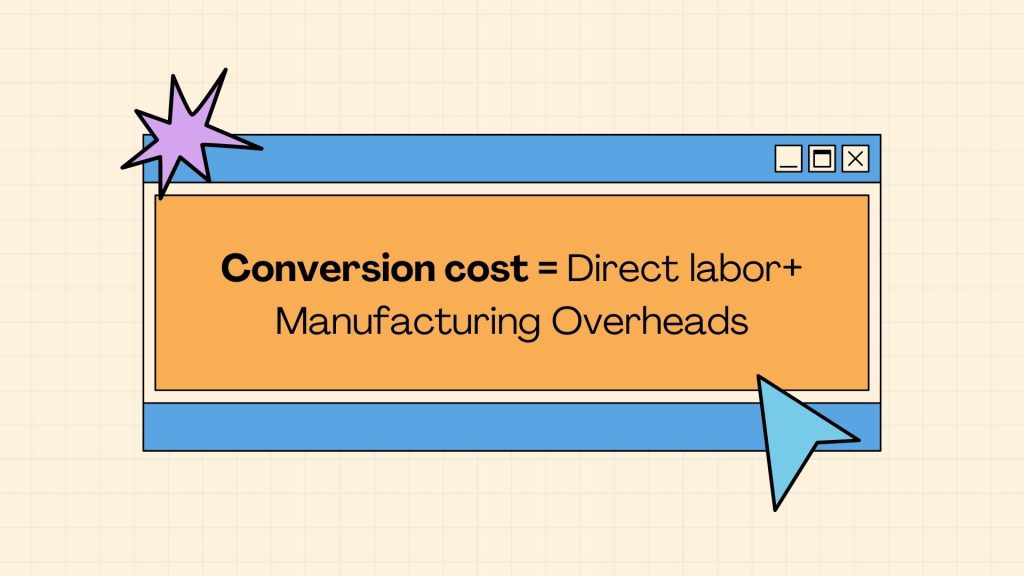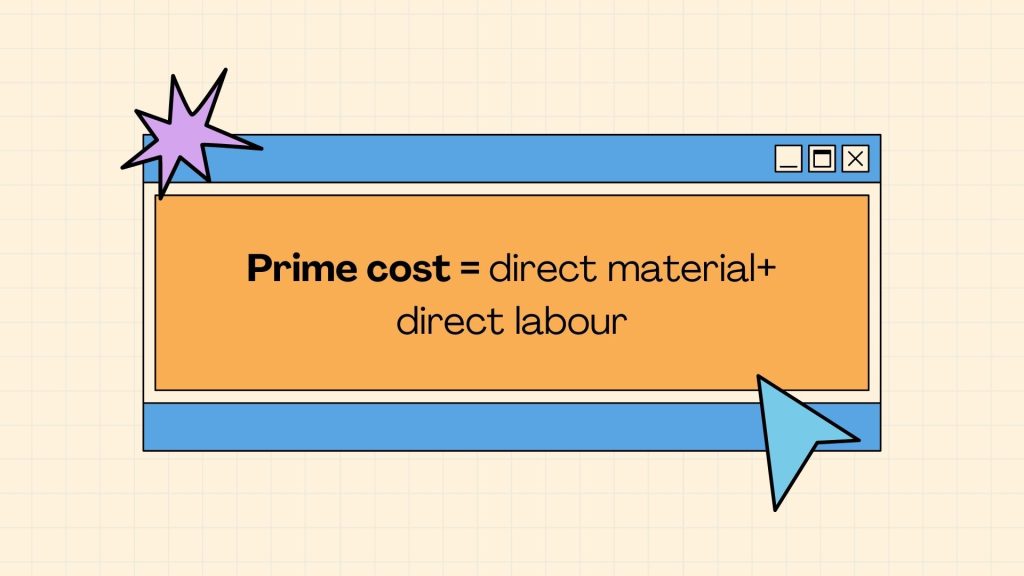Definition
Conversion cost is the cost required to convert raw material into finished goods. It includes direct labor and manufacturing overheads.
Explanation
Whatever product you use in your daily life from your toothbrush to your car was not created in this form from the beginning. Clearly, it went through rigorous production processes in manufacturing organizations to take its final form which we, the end-users, could use.
The concept of conversion cost is mainly linked to manufacturing firms responsible for converting raw substances into refined products. The cost involved in converting raw material into finished goods is called ‘conversion cost.’ The expenditure made on direct labor and manufacturing overheads makes up the total conversion cost of the production. Overhead and Direct labor are two out of three ‘elements of cost.
The formula for Conversion cost
The formula for conversion cost calculation comes to be:
Conversion cost = Manufacturing Overhead + Direct Labor

Components of Conversion cost
These two components of conversion cost are explained below.
Manufacturing overhead
Direct labor and direct materials, as their names indicate, are costs directly related to the production process. On the other hand, overheads are indirect costs incurred during production. Indirect costs are also indispensable expenses of production, but the reason for being labeled indirect is that they can’t be directly attributed to each production unit separately. For example, the power supply or electricity required to run the machinery cannot be individually assigned to the units produced. Still, without it, the production process cannot start or continue. Other examples of overheads include indirect materials, indirect labor, rent, taxes, insurance, tools, equipment, supplies, and utilities.
Direct Labor
Direct labor costs are the expenditures spent on factory workers directly involved in converting raw material into finished goods. For example, painters, assembly line workers, and machine operators work on the actual product. Whereas managers, policymakers, accountants, or sales staff are considered indirect labor because they are indirectly linked to the product through supervision, promotion, etc. Direct labor costs would include salaries, wages, benefits, bonuses, insurance, recruitment cost, training fees, pension funds, etc., paid to direct labor.
Benefits of Conversion cost
Identifying expenditures and keeping track of them gives a business its primary direction regarding income generation and profit margin calculation. Conversion cost calculation serves these benefits, which are listed below.
- Conversion cost allows a business to determine the efficiency of its production process regarding direct labor and overhead usage. The cost of input (conversion cost) should be less than the output (income from finished goods) for a production process to be efficient and effective. If some costs are not reaping desired output, these are identified as waste and eliminated by restructuring the process.
- Conversion cost helps develop ‘product-pricing models’ as it gives you the per-unit cost of each end product. Now, it becomes easier to set an incremental profit margin added to the per-unit cost to get a final price for the product.
- Conversion cost calculation is necessary as it gives COGS (cost of goods sold) to be reported in the income statement.
- Conversion cost also provides us with the value of beginning and ending inventory, which is to be reported in both the company’s balance sheet and income statement.
Drawbacks of Conversion cost
It does not consider direct materials cost, which is the third important element of the production process, which is why it cannot be relied upon for cost control. To include direct materials, we have to calculate the prime cost or utilize alternate methods like process costing and marginal costing.
Conversion cost example
Let us consider an example from XYZ Furniture Manufacturing Company, which incurred direct labor and factory overhead costs for December 2021. Total unit production amounted to 100,000.
| Particulars | Amount |
| Direct labor | $200,000 |
| Indirect labor | $105,000 |
| Indirect materials | $9,000 |
| Factory insurance | $12,000 |
| Equipment maintenance | $6,000 |
| Factory rent | $30,000 |
| Electricity expense | $70,000 |
Total manufacturing overhead = $ 105,000 + 9,000 + 12,000 + 6,000 + 30,000 + 70,000 = $232,000
Direct labor = $ 200,000
As, Conversion cost = Manufacturing overhead + Direct labor
= $ 232,000 + $200,000 = $ 432,000
Conversion cost per unit
To obtain the cost spent on each unit of the output, we use the following formula:
Conversion cost per unit = Total conversion cost/ Total no. of units
In the above example,
Conversion cost per unit = $ 432,000 / 100,000 = $ 4.32
Therefore, a conversion cost of $4.32 is spent for manufacturing every unit of furniture in the XYZ furniture company. The per-unit cost is important for determining the sale price through product-price models and obtaining a decent profit margin.
Conversion cost per Equivalent unit
There are three stages of production
- Raw materials
- Work in Process
- Finished goods
When materials are sent into production facilities, they go through several stages before becoming finished goods. Here we should note that every unit is not at the same stage of production throughout the process, and so some are completed sooner or later than others. The concept of equivalent units originates, which is used in process costing. It makes the calculation of production costs easier.
Some units might be partially complete during the manufacturing process, and others might be complete. This is so because the materials are added in different quantities and at different stages of production. Though, the overheads and direct labor remain somewhat constant throughout the period. While accounting for the units of output, it becomes confusing to include partially complete units. That is why the partially complete part of work-in-process units is calculated as equivalent units—again, considering the example of XYZ Furniture Company to elaborate this concept further.
The XYZ Furniture Company produced 100,000 completed units for December. Let’s suppose that another 15,000 units were in the work-in-process stage during the same month and were partially (50%) complete. This was so because these units are 50% complete with respect to conversion cost and 50% complete with respect to materials. Now, to obtain equivalent units following formula is used:
Equivalent units = No. of WIP units * percentage of completion
Equivalent units = 15,000 * 50% = 7,500
Therefore, we can say that 15,000 partially complete units are equivalent to 7,500 complete units.
Now to calculate cost per equivalent unit the following formula is used:
Cost per equivalent units = total cost /total equivalent units
Here, the total cost includes beginning inventory as well as the additional costs incurred during the production process. In the example of XYZ Furniture Company, there was zero beginning inventory, so the total costs including direct materials, direct labor, and factory overhead amounted to $462,000 ($432,000+30,000). An amount of $30,000 was further added to the production process.
Total units including equivalent = 100,000 + 7,500 = 107,500 units
Total Costs = $ 462,000
Cost per equivalent unit = 462,000/107,500 = $ 4.298
So, a cost of $ 4.298 is spent for manufacturing each unit of finished goods. This cost can also be separately assigned to totally complete units and WIP partially complete units in the following way.
Totally complete units = 100,000 * $ 4.298= $429,800
WIP equivalent units = 7,500 * $ 4.298= $ 32,235
So, a total cost of $429,800 is spent on producing 100,000 finished goods and a cost of $ 32,235 is incurred for making 7,500 equivalent finished goods.
Prime cost and conversion cost
Prime cost and conversion cost are two classifications of product costs where prime cost is the primary cost of production which can be directly traced to the finished goods. Prime cost is made up of Direct Labor and Direct Materials.
The formula for Prime cost
The formula for conversion cost calculation comes to be:
Prime cost = Direct materials + Direct Labor
Components of Prime cost
The two components of prime cost are explained below.

Direct Materials:
Direct materials are the primary building blocks that form the basic makeup of each unit of end products. These tangible constituents of a product can be immediately identified when looking at the product. For instance, when you look at a wooden chair you can tell that it has been assembled by a carpenter using wood and nails. Thus, the wood and nails are classified as direct materials, and the carpenter is considered direct labor. Another example is ice-cream, which is mainly made up of sugar and milk. Similarly, bread is made from flour and yeast by a baker. Generally, direct materials are the raw materials of production.
Direct Labor:
A baker in baking bread, a carpenter making wooden chairs, auto parts assemblers, painters, electricians, plumbers, and machine operators in factories are all examples of direct labor because they are directly working on creating a product. The wages, salaries, benefits, bonuses, insurance, etc. paid to these workers are direct labor costs.
Similarities and Differences between Prime cost and conversion cost
The similarities and differences between Prime cost and Conversion cost are detailed here.
Differences:
- Conversion costs, as discussed before, includes one direct cost (labor) and one indirect cost (overheads) as component of production while prime cost takes in both of the direct expenses of production.
- Prime cost can be directly traced to a product while factory overhead, a component of conversion cost, cannot be directly traced to a product.
- Prime cost calculation is important to determine the actual input costs involved in manufacturing. Conversion cost cannot be relied upon because it doesn’t include direct materials cost.
Similarities:
- Both prime cost and conversions costs are production costs.
- Both prime cost and conversion costs include direct labor.
- Both prime cost and conversion cost help determine the selling price of the product and ensure the production process’s efficiency.
Example of Prime cost
Prime cost can be calculated from the example of XYZ Furniture Company mentioned above.
Direct materials = $ 30,000
Direct labor = $ 200,000
Prime cost = $ 30,000 + 200,000 = $230,000
Prime costs and conversion costs are integral concepts in cost accounting because the accurate calculation and control for overhead, materials and labor costs are essential for successful business operations.
Conclusion
Conversion cost reflects the cost required to convert raw material into finished goods. There are two main components of conversion costs: direct labor and manufacturing overheads.
The amount of direct labor can be directly traced to the production process. On the contrary, manufacturing overhead is an indirect cost that cannot be traced to a single production unit. For instance, depreciation and electricity bills for the production facility cannot be accurately traced when the business produces multiple products.
On the other hand, prime cost only includes a direct cost. These costs include direct material and direct labor required to complete the work.
More reading on tothefinance